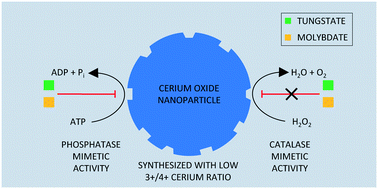当前位置:
X-MOL 学术
›
Environ. Sci.: Nano
›
论文详情
Our official English website, www.x-mol.net, welcomes your feedback! (Note: you will need to create a separate account there.)
Characterizing the phosphatase mimetic activity of cerium oxide nanoparticles and distinguishing its active site from that for catalase mimetic activity using anionic inhibitors
Environmental Science: Nano ( IF 7.3 ) Pub Date : 2017-07-12 00:00:00 , DOI: 10.1039/c7en00394c A. Dhall 1, 2, 3, 4 , A. Burns 1, 2, 3, 4 , J. Dowding 1, 2, 3, 4 , S. Das 3, 4, 5, 6, 7 , S. Seal 3, 4, 5, 6, 7 , W. Self 1, 2, 3, 4
Environmental Science: Nano ( IF 7.3 ) Pub Date : 2017-07-12 00:00:00 , DOI: 10.1039/c7en00394c A. Dhall 1, 2, 3, 4 , A. Burns 1, 2, 3, 4 , J. Dowding 1, 2, 3, 4 , S. Das 3, 4, 5, 6, 7 , S. Seal 3, 4, 5, 6, 7 , W. Self 1, 2, 3, 4
Affiliation

|
Cerium oxide nanoparticles (CeNPs) are potent reactive oxygen and nitrogen species scavengers and demonstrate beneficial antioxidant properties in both cell culture and animal studies. However, their environmental fate, particularly in animals, is still under investigation. Studies have shown that CeNPs at very high doses can be retained briefly in organs such as the liver and in the bone marrow. The interaction of these nanoparticles with their local environment plays a major role in their distribution and long-term stability. We have previously shown that CeNPs with a low 3+/4+ cerium oxidative state ratio exhibit both catalase and phosphatase mimetic activities. Here, we aimed at further characterizing the active site(s) involved in these catalytic activities using potentially inhibitory anions. Results indicated that tungstate and molybdate inhibited the phosphatase activity without altering the oxidative state of cerium atoms but were ineffective against catalase activity. This suggests that distinct chemistry and active sites are involved in these two catalytic activities. Additionally, it was observed that CeNPs in aqueous environments were more active, strongly suggesting that water plays an important role in the phosphatase activity. Given the abundance of phosphate and other metal anions in both tissues and the environment, studying the nature of catalytic activities of CeNPs and the surface chemistry involved will help us form a stronger understanding of their environmental fate and thus qualify their biomedical applications.
中文翻译:

表征氧化铈纳米颗粒的磷酸酶模拟活性,并使用阴离子抑制剂将其活性位点与过氧化氢酶模拟活性的活性位点区分开
氧化铈纳米颗粒(CeNPs)是有效的活性氧和氮物种清除剂,在细胞培养和动物研究中均显示出有益的抗氧化性能。但是,它们的环境命运,尤其是动物的命运,仍在调查中。研究表明,非常高剂量的CeNPs可以短暂保留在肝脏和骨髓等器官中。这些纳米颗粒与其局部环境的相互作用在其分布和长期稳定性中起着重要作用。先前我们已经表明具有3 + / 4 +铈氧化态比率低的CeNPs既表现出过氧化氢酶又表现出磷酸酶的模拟活性。在这里,我们旨在使用潜在的抑制性阴离子进一步表征参与这些催化活性的活性位点。结果表明,钨酸盐和钼酸盐可抑制磷酸酶活性,而不会改变铈原子的氧化态,但对过氧化氢酶活性无效。这表明这两种催化活性涉及不同的化学和活性位点。另外,观察到在水性环境中CeNPs更具活性,强烈表明水在磷酸酶活性中起重要作用。鉴于组织和环境中磷酸盐和其他金属阴离子的含量,研究CeNPs催化活性的性质和涉及的表面化学性质将有助于我们对它们的环境命运有更深入的了解,从而使它们具有生物医学应用的资格。
更新日期:2017-08-10
中文翻译:

表征氧化铈纳米颗粒的磷酸酶模拟活性,并使用阴离子抑制剂将其活性位点与过氧化氢酶模拟活性的活性位点区分开
氧化铈纳米颗粒(CeNPs)是有效的活性氧和氮物种清除剂,在细胞培养和动物研究中均显示出有益的抗氧化性能。但是,它们的环境命运,尤其是动物的命运,仍在调查中。研究表明,非常高剂量的CeNPs可以短暂保留在肝脏和骨髓等器官中。这些纳米颗粒与其局部环境的相互作用在其分布和长期稳定性中起着重要作用。先前我们已经表明具有3 + / 4 +铈氧化态比率低的CeNPs既表现出过氧化氢酶又表现出磷酸酶的模拟活性。在这里,我们旨在使用潜在的抑制性阴离子进一步表征参与这些催化活性的活性位点。结果表明,钨酸盐和钼酸盐可抑制磷酸酶活性,而不会改变铈原子的氧化态,但对过氧化氢酶活性无效。这表明这两种催化活性涉及不同的化学和活性位点。另外,观察到在水性环境中CeNPs更具活性,强烈表明水在磷酸酶活性中起重要作用。鉴于组织和环境中磷酸盐和其他金属阴离子的含量,研究CeNPs催化活性的性质和涉及的表面化学性质将有助于我们对它们的环境命运有更深入的了解,从而使它们具有生物医学应用的资格。



























 京公网安备 11010802027423号
京公网安备 11010802027423号